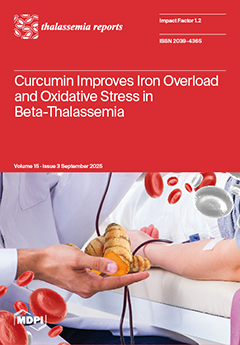The risk of anemia and iron overload is a global concern in beta (β)-thalassemia. The β-thalassemia primary treatment includes blood transfusion and iron chelation therapy; however, both are associated with risks such as anemia, iron depletion, overload, and oxidative stress if not adequately
[...] Read more.
The risk of anemia and iron overload is a global concern in beta (β)-thalassemia. The β-thalassemia primary treatment includes blood transfusion and iron chelation therapy; however, both are associated with risks such as anemia, iron depletion, overload, and oxidative stress if not adequately monitored. Therefore, this study investigates the effects of curcumin on anemia, iron overload, and oxidative stress in β-thalassemia. In this meta-analysis, search terms including “curcumin,” “Curcuma longa,” “curcuminoids,” “turmeric,” and “thalassemia” were used in Scopus and PubMed to identify studies published from inception to 15 February 2025. The quantitative analysis was performed using a meta-analysis web tool, and the effect estimates were reported as the mean difference (MD) or standardized mean difference (SMD), along with 95% confidence intervals (CI). Our analysis showed no significant effect on hemoglobin (
p = 0.1788) and red blood cell count (
p = 0.9534). In contrast, there was a significant decrease in serum ferritin [SMD = −0.24 (−0.46, −0.02),
p = 0.0335], non–transferrin bound iron (NTBI), [SMD = −0.59 (−0.98, −0.19),
p = 0.0039] and serum iron, [SMD = −0.30 (−0.60, −0.01),
p = 0.0425]. Furthermore, there was a reduction in reactive oxygen species; [SMD = −0.83 (−1.23, −0.44),
p < 0.0001] and malonaldehydes, [MD = −343.85 nmol/g Hb (−465.94, −221.76),
p < 0.0001]. A dose of 500 mg of curcumin was found to be more effective in reducing the NTBI. The findings suggest that curcumin may help reduce iron overload and oxidative stress in β-thalassemia; however, its effect on improving anemia appears to be limited. Given the small sample size of the included studies, we recommend that future research involve larger cohorts and employ rigorous methodologies to evaluate the therapeutic potential of curcumin in β-thalassemia thoroughly. Additionally, we recommend using curcumin-enhancing strategies to improve its bioavailability and administer an optimal yet effective dose.
Full article




